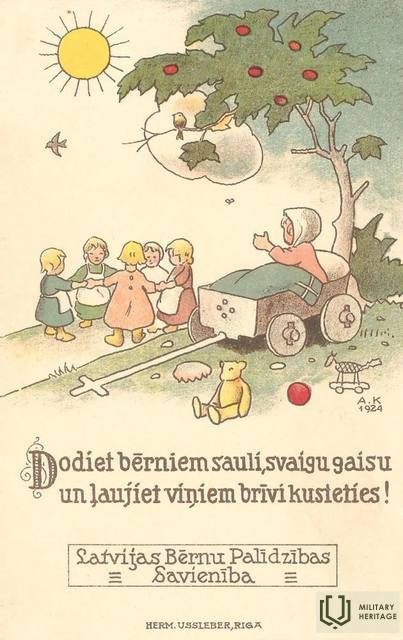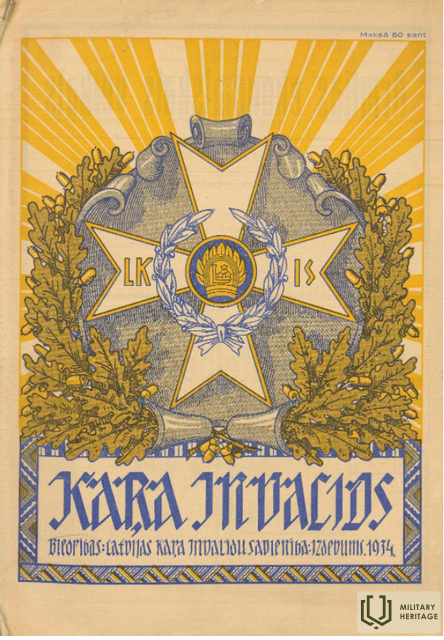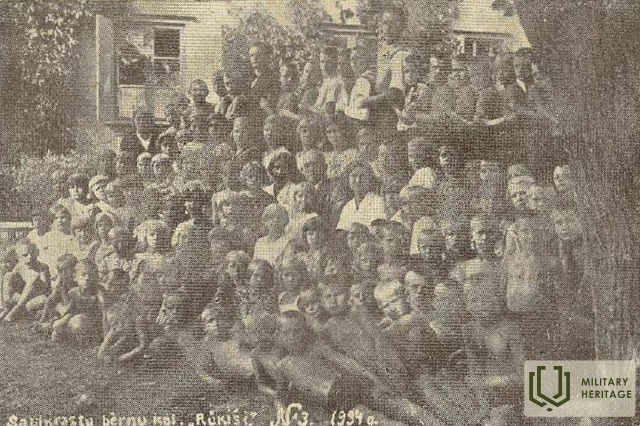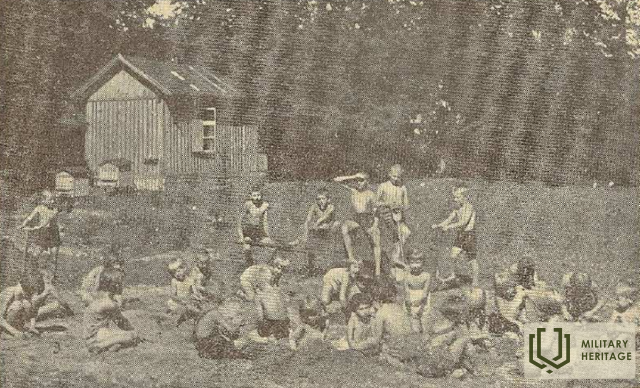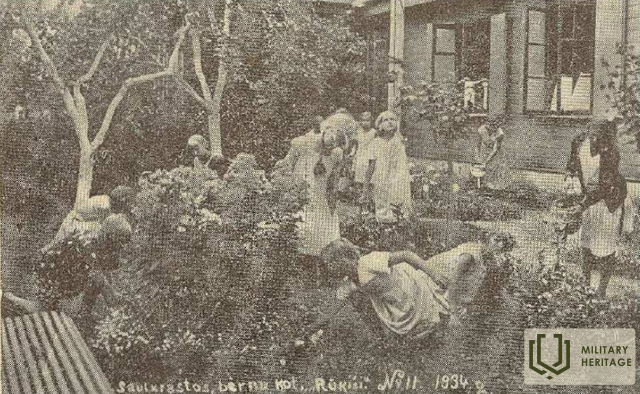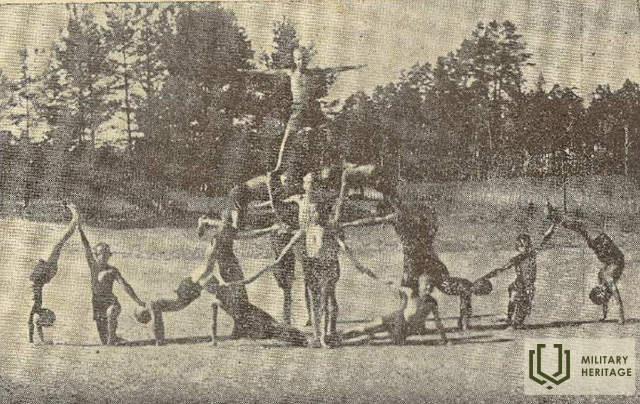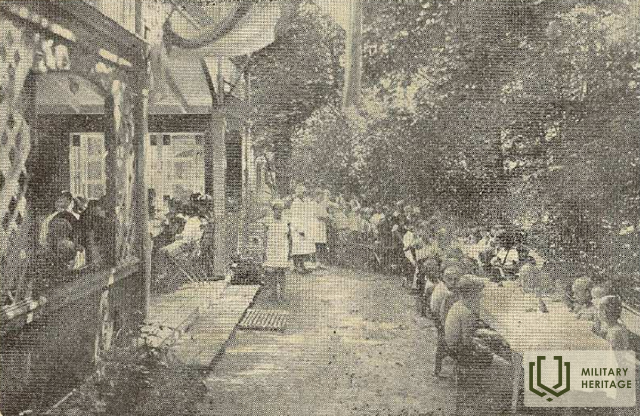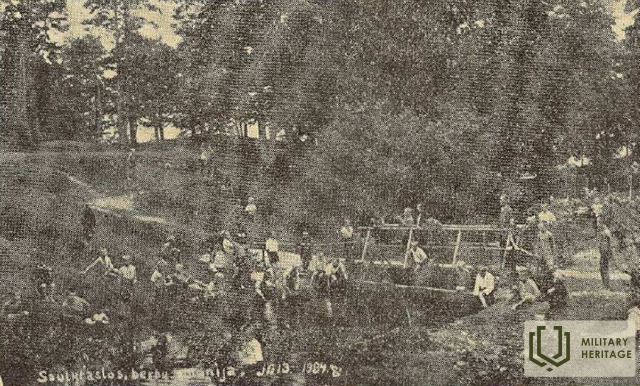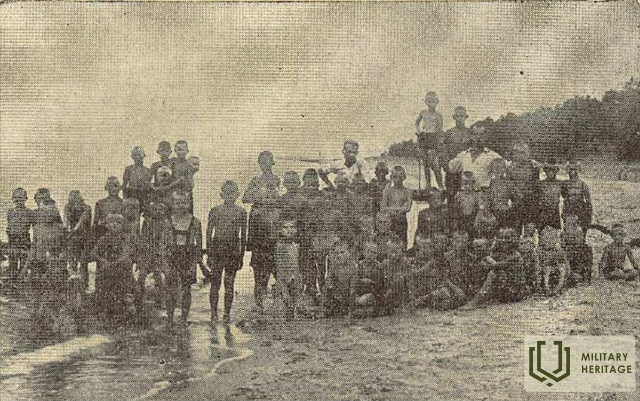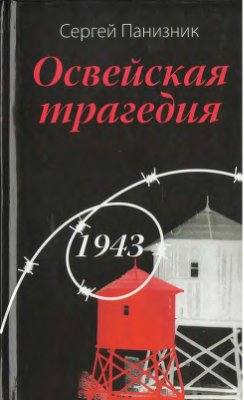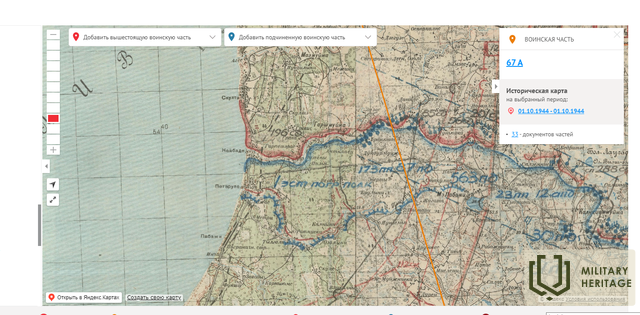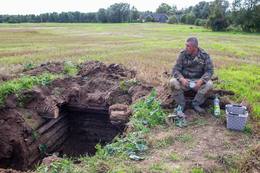Apie vaikų kolonijos „Rūķīši“ įvykius prieškario ir Antrojo pasaulinio karo laikotarpiais
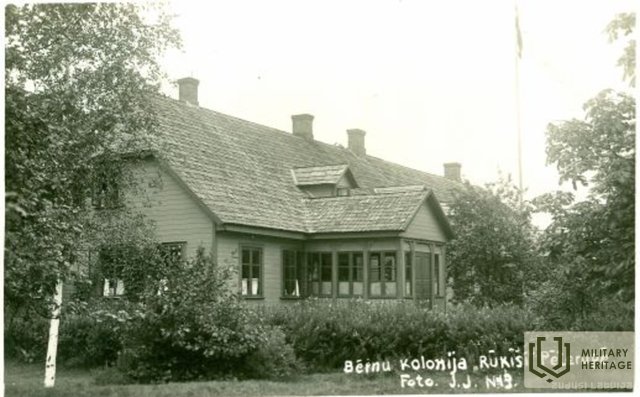
Vaikai buvo atimti iš partizanų rėmėjų šeimų. 1943 m. kovo mėn. Salaspilio stovykloje buvo 1100 vaikų. Apie 250 vaikų mirė nuo tymų, vidurių šiltinės ir kitų ligų, keli šimtai vaikų buvo perkelti į aplinkinių parapijų ūkius, o apie 300 vaikų atsidūrė vaikų namuose Rygos Jūrmaloje, Igatėje ir Saulkrastuose.
Saulkrastuose vaikai atsidūrė Latvijos vaikų pagalbos draugijos vaikų kolonijoje „Rūķīši“.
Apie tai, kaip susikūrė Latvijos vaikų pagalbos draugijos vaikų kolonija „Rūķīši“
1929 m. dėl mokinių trūkumo buvo uždaryta Plade keturmetė mokykla, kuri iki 1912 m. buvo vienintelė mokykla pajūrio žvejų kaimuose.
1930 m. ten pradėjo veikti Latvijos vaikų pagalbos draugijos vaikų kolonija „Rūķīši“, kurioje gyveno apie 110 vaikų.
„Kolonijoje vaikai gauna paruoštą maistą, patalynę, prausia, teikia medicininę priežiūrą ir auklėtojų priežiūrą. Metinis kolonijos biudžetas yra nuo 13 000 iki 15 000 ls. Vaikų dienos metu vaikams teikiami jų gebėjimus atitinkantys namų darbai, savarankiška priežiūra, mankšta, dainavimas, piešimas, žaidimai, vaikų užduotys, ekskursijos po artimiausią apylinkę ir kt. Sąjunga svetingai priima visus vargstančius vaikus kolonijoje be jokios diskriminacijos. Nuo 1930 m. vasaros į „Rūķīši“ taip pat buvo priimti keli vaikai Karo invalidų paramos fondo tarybos lėšomis.“ (Kara Invalīds, Nr. 1 (1934-01-01))
Iš periodinio leidinio sužinoma, kad kolonijoje „Rūķīši“ taip pat apsistojo vaikai iš Lietuvos ir Estijos: „Vaikų vasaros kolonijoje Saulkrastuose apsigyvens 200 vaikų. Latvijos vaikų pagalbos draugija pirmadienį Saulkrastuose atidarys savo vaikų vasaros koloniją „Rūķīši“, kurioje pirmoje pamainoje bus priimta apie 100 vaikų. Vaikai kolonijoje praleis 6 savaites. Tiek pat vaikų bus priimta ir antroje pamainoje. Iš Lietuvos gautas atsakymas, kad šią vasarą ji nesiųs savo vaikų į Latviją, tačiau Estijos vaikų pagalbos draugija dar neatsakė.“ (Latvijas Kareivis, Nr. 131 (1940-06-13))
Apie įvykius Rūķīšių kolonijoje Antrojo pasaulinio karo metu
1982 m. V. Strazdinės straipsnis „Atminties sargyboje“ leidinyje „Darba balss“ (liet. Darbo balsas), kuriame Elza Gailītė dalijasi savo prisiminimais apie Antrojo pasaulinio karo įvykius leidinyje „Rūķīši“:
Elzos Gailītės (86 m.) kalbėjimo stilius iš pradžių lakoniškas:
1943 m. birželį Saulkrastuose „Rūķīši“ buvo įkurta prieglauda Salaspilio vaikams, kurių tėvai buvo įkalinti, sunaikinti arba išvežti į Vokietiją, sako ji, ir rankose turi tai įrodančius dokumentus. – Į Saulkrastus buvo atvežti paskutiniai gyvi 2–12 metų vaikai. Apie 70 vaikų, sergančių, išsekusių, skarmalais... Jie sirgo niežais, utėlėmis, skarlatina... Penkių iš jų nepavyko išgydyti, jie mirė. Vaikais rūpinosi 12 žmonių personalas. Vadovė buvo Lidija Korolova. Pas mus vaikai pamažu sveiko, buvo maitinami ir jais rūpinamasi.
Gryname ore, saulėje, prie jūros... Vėliau mūsų stovykla buvo perkelta į Zimmermanų namus (savininkas buvo repatrijuotas į Vokietiją), esančius ant Ķišupytės upės kranto. Tai buvo jau 1944 m. Anksčiau ten buvo karo belaisvių stovykla.
Gūsteknių šeima mirė nuo šiltinės. Gyvenome čia apie pusę metų, iki 1944 m. rugsėjo 25 d. Kol fašistai įsakė mums išsikraustyti (per pusantros valandos), vykti su armija... Nusprendėme: grįžti į „Rūķīšius“. Išsiskyrėme. Keturi ar penki vaikai turėjo savo motinas. Tie, kurie išvyko, nebuvo toli nuėję. Maži, trejų metų... Batukai ant kojų, šlepetės, kurios krito... Jie pradėjo verkti. Taigi visi grįžo. Visi susispietėme dideliame rūsyje. Susirinko apie 80 žmonių. Susėdome ir laukėme, kas bus. Fašistai pradėjo viską sprogdinti. Jie susprogdino geležinkelį, tiltą... Vieną iš tarnų, jis buvo kalinys, pasiuntėme atgal į Zimmermanų namus nusipirkti maisto. Ryte buvo tylu. Išslinkome iš rūsio ir nuėjome į „Rūķīšius“.
Ten Paukštė Mama mums didelėje krosnyje kepė duoną.
– O gal ji buvo jūsų aptarnaujančio personalo narė?
– Ne. Ji buvo tiesiog labai geras žmogus, padėjo mums iš draugiškumo, kaip kaimynė.
Visuose darbuose. Net ir aprūpinant maistu. Prašau, surask ją: ji galės tau daug papasakoti. Taip, surask jas abi – Motiną Paukštę ir Tėvą Paukštį...
Miltų liko tik vienam kepsniui. Jei išeisime, numirsime iš bado, manėme.
Vienas antifašistinis vokietis pasakė: „Mūsiškiai ilgai nelaikys. Mes traukiamės. Jums geriausia likti čia pat.“... Rugsėjo 25-osios vakarą, penktą valandą, artėjo fronto linija. Dvi sunkios dienos ir naktys prabėgo apšaudant... Negalite ilgai laikyti vaikų rūsyje. Jie bėga į vidų, iš jo. O paskui bėga atgal, šaukdami: „Mūsų žmonės!“ Netrukus prieina ir Raudonosios armijos kareiviai, sveikinasi. Džiaugsmas iki ašarų... žvalgai, snaiperiai lipo į medžius. Mes jiems papasakojome apie situaciją. Kitaip jie būtų patekę į didelę bėdą. Jie užėmė pozicijas, pastatė ginklus, prasidėjo šaudymas. Sudrebėjo žemė, langai...
– Taip, Saulkrasti buvo paleistas spalio 11 d., – pridurčiau.
– Buvo labai kruvinų mūšių...
Važiuodami per Skultę, pirmą kartą pamatėme naujuosius „Katiušos“ tankus. Limbažose mus apgyvendino tuščiame name. Miegojome ant grindų, be šieno, be nieko. Parduotuvės buvo tuščios. Tada komendantas atsiuntė pieno ir duonos. Visiems buvo po vieną puodelį. Jie atsiuntė mėsos ir kibirą. Virėme kibire. Buvo sunku. Bet buvo... ramybė. Bombos nebesprogo, sviediniai nebeskraidė virš galvos, vaikai nusiramino, nebepuolė į isteriją, neberėkė iš siaubo dėl sužeistųjų, žuvusiųjų, arklių, dėl visų gyvų dalykų... Limbažose namai buvo daugiaaukščiai. Jie davė mums lovas, drabužius, viską. Laukėme Pergalės dienos. Vaikai pradėjo laukti savo giminaičių. Daugelis tėvų buvo išsiųsti į Vokietiją. Jie buvo surasti tik po daugelio metų. Stovykla gyvavo iki 1945 m. vasaros. Vaikai buvo paskirstyti į kitas vaikų įstaigas. Dabar daug Baltarusijos vaikų liko Latvijoje. Viena mergina instinktyviai pajuto... kad sutiko savo mamą, bet nebesuprato mamos kalbos.
– Kaip vaikai ištrūko iš Salaspilio?
– Kaip rašytojas Paniznikas atrado šią „Gnomų“ istoriją?
Rašytojo sesuo gyvena Kauguriuose. Jis dažnai važinėdavo į Rygą ir apie ją skaitydavo 1978 m. „Rīgas balse“. Tačiau susidomėjo, nes „Rūķīši“ daugiausia buvo baltarusių vaikai.
Rašytoja susirado Elzą Gailītę. Vėliau buvo apsikeista laiškais ir atlikta daug tyrimų. Elza Gailītė jau gavo dovanų knygą su autorės dedikacija. Ji vadinasi „Po sudegusių kaimų...“. Joje yra skyrius „Saulėtosios pakrantės „nykštukai““.
Knyga yra apie Petrą ir Viktorą, kurie vaikystėje tarnavo savo šeimininkams, kiekvienas savarankiškai. O kai jie susitiko po 20 metų, sužinojo: abu yra broliai, baltarusiai, rygiečiai; vienas dabar buvo latvis, kitas rusas...
Bet Nadežda Boguša atsiuntė padėkos laišką tuometinei „Rūķīši“ ūkio vedėjai Elzai Gailītei.
Saulkrastuose nebėra kam papasakoti apie šiuos įvykius. Net Putnio motinos ir Putnio tėvo nebėra... jie ten gyvena jau 20 metų. Sūnūs patvirtina, kad prieglauda egzistavo. Marti Hilda apie savo uošvę sako: „Ji buvo nuostabiai malonus žmogus.“
Nerekonstruotų „Rūķīšių“ nuotraukos: jų taip pat neradome. Ir staiga, po dvejų metų paieškų, radome juos savo bibliotekos istorinės medžiagos archyve, kurį surinkome penktojo dešimtmečio antroje pusėje.
Ir savo užrašų knygelėje randu užrašytą komentarą iš filmo: „Esame tarp vakarykščio davėjo ir rytojaus ėmėjo. Ir jiedu negali susitikti, nebent būtume viduryje.“
Ištyrus informaciją, nustatyta, kad Elzos Gailītės memuaruose minima Sergejaus Panizniko knyga rusų kalba vadinasi „Osvejskaja трагедия 1943“.
Kolonija „Rūķīši“ Antrojo pasaulinio karo metu tarnavo kaip vaikų namai ir yra didžiulė padėka tiems žmonėms, kurie rūpinosi vaikais, likusiais be tėvų ir patyrusiais karo siaubą, atskirtais nuo tėvų ir išsklaidytais po visą Latviją.
http://kamunikat.org/usie_knihi?pubid=44344&lang=EN
Latvijos nacionalinės bibliotekos periodiniai leidiniai, Karo invalidas, Nr. 1 (1934-01-01)
Latvijos nacionalinės bibliotekos periodiniai leidiniai, „Latvijos kareivis“, Nr. 131 (1940-06-13)
Latvijos nacionalinės bibliotekos periodiniai leidiniai, 1982 m. „Darba balss“ V. Strazdinės straipsnis „Atminties sargyboje“
Inga Zemīte „Saulkrasti – nuo seniausių laikų iki Latvijos nepriklausomybės atkūrimo“, išleido Saulkrastų rajono taryba
https://lv.wikipedia.org/wiki/Salaspils_koncentracijos_stovyklos
Susijusi laiko juosta
Susijusios vietos
Antrojo pasaulinio karo vokiečių armijos bunkeris
Jis buvo įsikūręs netoli namo „Brankšoje“, javų lauke.
2021 m. rugsėjo 2 d., vadovaujant Saulkrastų krašto istorijos entuziastui Andriui Grabčikui, bendradarbiaujant su žemės ūkio paskirties žemės nuomininke Ines Karlova, Antrojo pasaulinio karo metu Siguldos gynybos linijoje buvusiame vokiečių armijos bunkeryje buvo atlikti kasinėjimo darbai.
„Nuo bunkerio pastatymo praėjo 77 metai, patyrę ir sovietų armijos puolimą, ir per jį važiavusią žemės ūkio techniką. Tik prieš 3 metus jis iš dalies sudužo sunkiosios technikos smūgiams. Kad grindys nepasemtų vandens, buvo įrengta drenažo sistema su vandens kaupimo rezervuaru prie įėjimo, kuris prireikus buvo nusausinamas. Bunkerio grindys sumūrytos iš 10 cm skersmens apvalių rąstų ir buvo uždengtos šiaudais. Šis bunkeris nėra vienas iš didžiausių, bet jo visiškai pakanka maždaug 6 žmonėms. Šis bunkeris ne vienintelis šioje teritorijoje, bet vienas iš nedaugelio, kuris yra gerai išsilaikęs.“ – taip apie bunkerį pasakoja Andris Grabčikas.
Paskelbus informaciją internete, iš istoriko ir Saulkrastų dviračių muziejaus savininko Janio Seregino gautos 2 nuskenuotos istorinės nuotraukos su užrašu „29.08.44, Saulkrastai, Vidrižų valsčius“ ir komentaru: „Nuotraukos gautos iš Saulkrastų moters, kuri dabar jau mirusi. Pasak jos, Saulkrastuose apsigyveno pabėgėliai iš Pskovo ir Leningrado sričių, kuriuos vokiečiai išvijo iš namų atsitraukimo metu. Jie buvo įdarbinti kasant apkasus gynybos linijoje netoli Ķišupės. Vienoje iš nuotraukų matyti miške dirbantys žmonės. Tokiu būdu buvo gauti rąstai, kuriuos dabar galime matyti bunkeryje netoli Brankšų. Antroje nuotraukoje matyti, kaip jie šeriami paskirstymo punkte arba prie namo įrengtoje virtuvėje. Manau, kad tai Brankšų malūnas.“
Bunkeris išliko nuo Antrojo pasaulinio karo laikų Siguldos gynybos linijoje.
Bunkerio vieta pirmą kartą buvo ištirta 2021 m. balandžio mėn., tačiau dėl aukšto gruntinio vandens lygio kasimo darbai negalėjo būti atliekami.
Bunkeris buvo įrengtas žemės ūkio paskirties žemėje ir, atlikus iškasimus bei tyrimus, buvo užpiltas taip, kad netrukdytų žemės ūkio darbams.




